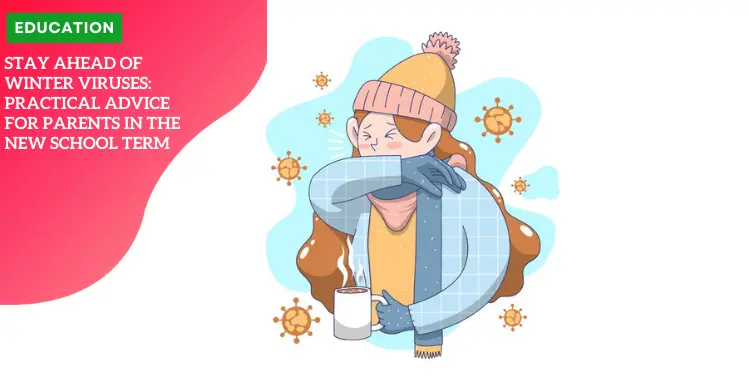Stay Ahead of Winter Viruses: Practical Advice for Parents in the New School Term

Importance of Teaching Good Hygiene Habits
The safeguarding of our children’s health can often begin with something as simple as hand-washing. Health experts consistently tout the effectiveness of this practice in keeping harmful viruses at bay. But why is regular hand-washing so crucial, especially in the context of a bustling school environment?
Regular Hand-Washing: A Virus’s Nemesis
It’s not just about washing hands; it’s about how and when we do it. The act of hand-washing with soap and water works ingeniously. It breaks down the grease and dirt that carry most germs, effectively rendering viruses harmless. In fact, studies have shown that regular hand-washing can reduce the risk of respiratory infections by 16-21%. That’s a significant shield against common winter viruses that tend to spike as children return to school.
Unseen but Not Unfelt: Viruses on Hands
We touch countless surfaces every day: doorknobs, tablets, toys, and more. What’s invisible to the naked eye is that these surfaces can harbor viruses like the common cold, flu, and even stomach bugs. These pathogens can linger on hands for hours, making it easy to transfer them to our mouth, nose, or eyes. By establishing and maintaining good hygiene practices such as hand-washing before meals, after using the restroom, and after sneezing or coughing, we can cut down the potential chain of infection significantly.
A Lesson in Hygiene: Protecting Everyone
Good hygiene habits go beyond personal protection; they’re a community service. When children learn to maintain good hygiene, they’re not only safeguarding themselves but also their classmates, teachers, and families at home. Teaching children the importance of hygiene and its impact can foster a sense of responsibility and community well-being. After all, a healthy community starts with healthy individuals, and healthy habits start with education.
Strategies to Stop the Spread of Stomach Bugs
As winter approaches, so does the rise in sickness bugs such as norovirus and E. coli. These common culprits are infamous for causing stomach-related ailments, like diarrhea and vomiting, especially in younger children. It’s not just about the discomfort these illnesses cause; they can be highly contagious, leading to widespread absenteeism in schools and a substantial disruption in learning.
Rise in Sickness Bugs
Why do we see an uptick in these bugs during the colder months? Norovirus, also known as the winter vomiting bug, thrives in cooler environments and closed spaces, making schools a hotbed for transmission. E. coli, on the other hand, is a bacteria that can spread through contaminated food or water, as well as person-to-person contact. These germs can linger on surfaces or hands and are easily passed around when children interact closely with one another. When one child falls ill, it’s a race against time to prevent a domino effect throughout the classroom.
Importance of Disinfection
One of the most effective defenses against these unwelcome invaders is maintaining a clean environment. Bleach-based products are particularly adept at disinfecting surfaces and killing off the pathogens responsible for these stomach bugs. Cleaning high-touch areas like doorknobs, bathroom fixtures, and toys becomes increasingly important in communal spaces like schools where children are in constant contact with shared items. By regularly wiping down these surfaces, we can significantly reduce the potential for outbreaks.
Hand-Washing with Soap
Complementing thorough cleaning practices, hand-washing with soap stands out as a simple yet powerful tool in our arsenal. Regular and proper hand hygiene breaks the chain of infection, preventing the transfer of viruses and bacteria from our hands to our mouths. After using the restroom, before eating, and after sneezing or coughing, encouraging children to wash their hands properly is a habit that benefits everyone. It’s a straightforward message that has profound implications: Wash your hands and stop the bugs in their tracks.
Impact on School Environment
The strategies mentioned not only protect individual children but also fortify the school environment against the tide of infectious bugs. Schools that implement rigorous cleaning protocols and promote regular hand-washing see fewer cases of stomach bugs. This means more days in the classroom, uninterrupted learning, and a healthier school community. When children understand the importance of these practices, they carry them beyond school walls, extending protection to families and even the wider community.
Knowing When to Keep Your Child at Home
As winter viruses loom, a key question for parents is: When should my child stay home from school? Understanding the criteria for keeping a child at home is crucial not only for the well-being of your own youngster but also for the health of classmates and teachers.
Recognizing Symptoms That Mean Stay Home
The first sign that you might need to keep your child at home is a high temperature. Fever is the body’s way of fighting infection, and it can be a clear indicator that your child is unwell. Alongside fever, if your child is experiencing fatigue, persistent coughing, or seems generally out of sorts, it’s best to err on the side of caution. These symptoms could be signs of a contagious condition, and rest at home can speed up recovery while preventing the spread of illness at school.
The 48-Hour Rule for Gastrointestinal Issues
When it comes to stomach bugs, it’s essential to follow the 48-hour rule. This means if your child has had any episodes of diarrhoea or vomiting, they should not return to school until 48 hours have passed since the last incident. This timeframe helps ensure that they are no longer contagious and reduces the risk of an outbreak among their peers. It’s not just about comfort; it’s about containment.
Post-Antibiotics: The 24-Hour Guide
If your child has been prescribed antibiotics for an infection, another key guideline is to keep them at home for at least 24 hours after the first dose. This allows time for the medication to start working and decreases the likelihood of spreading bacterial infections. Early intervention with antibiotics can be critical, so always seek medical advice when your child shows signs of an infection.
Encouraging Vaccination for Flu Prevention
When it comes to warding off the flu, a stitch in time saves nine—or in this case, a quick spritz up the nose. UK health officials endorse the nasal spray flu vaccine as the best line of defense for children against influenza. This ‘quick and painless’ method is especially designed for young ones, making the experience less intimidating and more child-friendly.
A Nasal Spray That Makes a Difference
The beauty of the nasal spray vaccine lies in its simplicity and ease of administration. No needles mean no tears, and for busy parents and squirmy kids, this translates to a stress-free vaccination experience. Not only is the process swift, but according to research, the vaccine itself is highly effective in preventing the flu, which can lead to serious complications, particularly in young children.
Tackling Low Vaccine Uptake Among Pre-Schoolers
Despite its availability and benefits, there’s a concerning trend: the uptake of the flu vaccine among pre-school children is lower than we’d hope. This age group is particularly susceptible to the flu, and the illness can be severe, sometimes resulting in hospitalization. It’s crucial to raise awareness among parents about the vaccine’s importance, ensuring that they understand the potential gravity of the flu and the protection the vaccine offers.
Who Can Get the Vaccine?
In the UK, the flu vaccine is available for free to children over a certain age. In Wales, England, Scotland, and Northern Ireland, eligibility criteria may vary slightly, but generally, children aged 2 to 11 are offered the vaccine. For exact details, parents should check with their local health services. Emphasizing these eligibility guidelines helps underscore the importance of taking advantage of the vaccine to safeguard children’s health during the risky winter months.
By vaccinating children, we not only protect them but also help shield vulnerable members of the community. The flu virus spreads easily, and a vaccinated child is one less carrier in the chain of transmission. Thus, getting your child vaccinated is a public service, contributing to the wider effort to keep our communities healthy.
Conclusion and Call-to-Action
As we wrap up our discussion, let’s revisit the vital steps that can help keep our children safe from winter viruses. The collective implementation of these measures by parents, schools, and communities can significantly reduce the spread of illnesses. Ensuring that our kids practice good hygiene habits, particularly regular hand-washing, is a simple yet powerful tool in combating the transmission of viruses. We’ve learned that these microorganisms can linger on little hands, making it crucial for children to scrub away germs effectively.
Beyond personal hygiene, maintaining cleanliness at home and in school settings is essential. The rise of stomach bugs like norovirus and E. coli has shown us the importance of using bleach-based products for disinfecting surfaces. Coupled with diligent hand-washing, these strategies form a robust defense against the onslaught of infectious agents within educational environments.
Moreover, understanding when to keep your child at home is pivotal in preventing the spread of sickness. Fever, general malaise, and digestive disturbances signal that a child should rest and recover away from school. To curb the spread of stomach bugs, it is recommended to wait 48 hours after symptoms subside before sending children back to school. And if antibiotics are necessary, a day at home post-treatment helps ensure recovery and reduces the risk of contagion.
Vaccination remains one of the most effective preventive measures against flu. With the availability of the nasal spray vaccine, safeguarding our children’s health has never been easier. Yet, we’ve noticed a concerning trend: many pre-schoolers remain unvaccinated despite being eligible for this protection. It’s imperative to increase awareness among parents about the vaccine’s benefits, not only for their own children but also for the community at large.
It’s time for all of us to take action. Your involvement as a parent is invaluable in protecting not just your child but every child they come into contact with. By following the advice outlined here and ensuring your children receive recommended vaccinations, you’re contributing to a healthier, more resilient community. So, let’s join forces this winter term:
- Teach and reinforce proper hand-washing techniques with your kids.
- Be vigilant in cleaning your homes and advocate for sanitary practices in schools.
- Keep your child at home when they’re unwell and follow guidelines for their return to school.
- Seek out vaccinations for your children, especially the flu vaccine, to fortify their defense against viruses.
The actions you take today have a ripple effect, extending far beyond your family. Together, we can diminish the impact of winter viruses and ensure that our children experience a healthy and uninterrupted school term. Let’s embrace our responsibility and act now for the well-being of all. Your efforts are a testament to the love and care you have for your children and community. Remember, prevention is better than cure, and together, we





